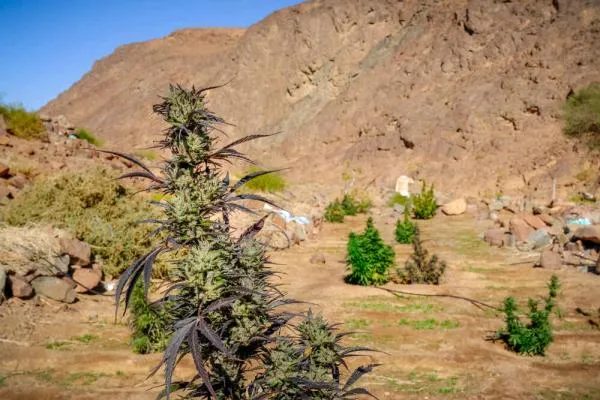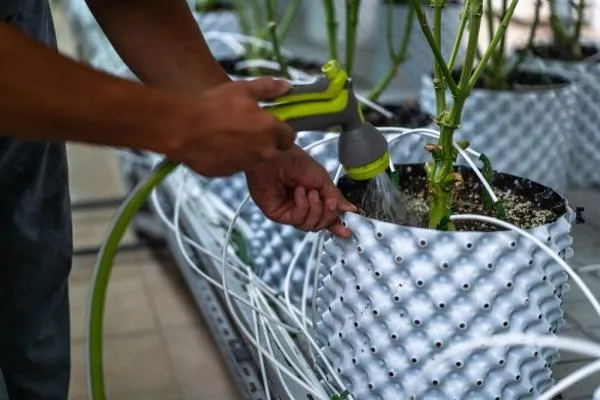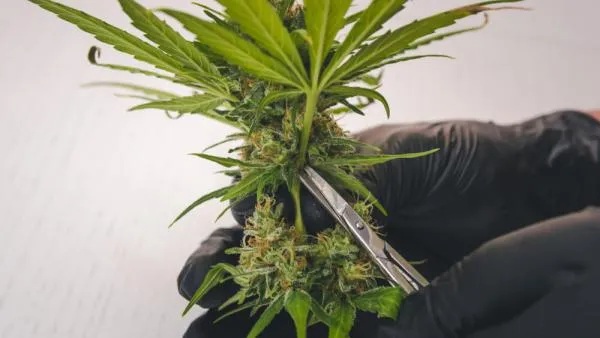What is Super Cropping?
Super cropping is a high stress training (HST) technique used in cannabis cultivation that involves deliberately damaging the stem of a cannabis plant in a controlled way to encourage lateral growth. The idea is to bend, pinch, or break the stems in a way that allows them to recover and grow back stronger and on a slightly wider trajectory. The wider shape allows for more efficient distribution while the now stronger branches are able to support heavier bud development.
- What is Super Cropping?
- Why should you super crop your cannabis plants?
- How much does super cropping increase yield?
- How early can you super crop cannabis?
- Can I super crop during the flowering stage?
- How long do plants take to recover from super cropping?
- How to super crop marijuana
- How to repair tears or broken branches
Why should you super crop your cannabis plants?
Super cropping is a training technique that involves selectively damaging the inner fibers of branches, while keeping the outer lining intact. Although this might seem counterintuitive, this type of stress can actually benefit your plants by promoting vigorous vegetative growth and improved bud development.
In nature, female cannabis plants produce trichomes rich in cannabinoids such as THC, as a defence mechanism against predators and other stressors. By inflicting damage through super cropping, it is believed that the plant's natural defence mechanisms will be triggered, resulting in an increase in nutrient uptake and growth.
In essence, super cropping can be seen as a way to "trick" the plant into producing more of its natural defence compounds, which ultimately leads to higher yields and more potent buds.
What are the benefits of Super Cropping?
- Increased yields: With super cropping, you can encourage your cannabis plants to grow more colas (the bud sites where the flowers form), which will result in higher yields.
- Improved light distribution: Super cropping can help you create a more even canopy of buds, which improves light distribution leading to more increased growth.
- Increased potency: When you super crop a cannabis plant, you stress it in a controlled way, which can sometimes lead to a slight increase in THC and other cannabinoids, potentially resulting in more potent flowers.
- Better airflow: By bending and manipulating the stems of cannabis plants, you create more space between the branches, which can improve airflow and reduce the risk of mold or mildew.
- Cost saving: Super cropping is a low-tech, low-cost method of training your cannabis plants that doesn't require any special equipment or expensive tools. Making it a great option for budget-conscious growers or those who want to experiment with different techniques without breaking the bank.

How much does super cropping increase yield?
When done correctly super cropping can certainly increase yield, however the amount of increase depends on the strain you are growing, the conditions and your skill level.
Let’s say you are growing a big yielding strain in ideal conditions, then you could expect to increase yield by 20-30%. However, other factors like quality of lighting, watering, nutrients, the soil and pot size play a larger part in yield so its important that you get this right first rather than relying on super cropping alone.
It's worth noting that super cropping can also be risky, especially for inexperienced growers or plants that are already stressed. If not done correctly, super cropping can damage the plant, reduce yield, or even kill the plant. So, while super cropping can potentially increase yield, it's important to use the technique with care and caution.
How early can you super crop cannabis?
For new growers, it is advisable to super crop plants only once, during the late vegetative stage, ideally 3-7 days before flipping to flowering. This time interval allows the plants time to recover from the stress caused before they begin redirecting their resources to bud development.
However, it is important to avoid super cropping plants that are already dealing with pest infestations, nutrient deficiencies, or any other negative stress since super cropping is a high-stress technique that requires plants to be in excellent health to withstand it.
For those with a little more experience, you can super crop a second time during the first two weeks of the flowering stage, as this period is characterized by an explosive growth phase, also known as "stretching." After that, it's recommended to let the plants recover and focus on flowering.
Super cropping in the early veg stage
Alternatively some growers claim that super cropping cannabis plants early on during the veg stage once the third node has appeared is the best time for achieving bigger yields. This approach works best however, when partnered together with low-stress training (LST) throughout the vegetative stage, which should lead to bigger and stronger plants by the time you reach the flowering stage. The benefit of doing it earlier is that if you do mess up and cause any stress your plants have even more time to recover.
Can I super crop during the flowering stage?
Super cropping is normally done during the vegetative stage, it is possible to super crop during the early flowering stage. However, it isn't recommended because it causes stress to the plant which could hinder bud production resulting in reduced yields.
During the early flowering stage the plant is still growing and will recover more quickly from the stress of super cropping. However, if you decide to super crop during the flowering stage, it's important to be very gentle and avoid causing any damage to the bud sites.
Super cropping during the flowering stage can potentially delay the maturation of the buds and extend the overall flowering period. Therefore, it's best to stick to doing it only during the vegetative stage and to allow the plant to focus solely on bud production during the later stages of flowering.

How long do plants take to recover from super cropping?
The recovery time after super cropping can vary depending on the strain, overall health of the plant, and how much damage is done while super cropping. However, as a general rule of thumb, most plants take about 5 to 10 days to recover from super cropping.
During this time, the plant may show signs of stress and shock, and you might notice a few leaves drooping or wilting. Don't worry, this is a normal response to the stress of super cropping, and the plant will typically recover within a week or so.
How to super crop marijuana
Super cropping your cannabis plant is a relatively simple process that requires only a few tools: your fingers, a healthy plant, and in case of any mishap, heavy tape like duct tape. The goal of super cropping is to create a flat canopy by gently pinching and bending the stems of the plant, ensuring that no single stem dominates the rest. Here are the key steps to follow:
- Choose plants to super crop during the vegetative stage when the plant has grown substantially and has many healthy branches.
- Choose the branches you want to super crop. If the plant has multiple colas, they should all be cropped at the same location on each cola. If there is only one, the greener top of the plant should be super cropped. The best stems for cropping are older but still green, and pliable enough that they can be easily bent; not woody like the rest of the stalk.
- Gently pinch and bend the branches. This is the core step in super cropping marijuana, and it’s a very delicate balance. The branch needs to be bent enough that it sit at a 90 degree angle without bending back up towards the light. Cannabis plants have an innate ability to find the light and move towards it, so growers need to make sure the plants are bent enough that they are actually unable to do this. However, the bend cannot be so great that it actually breaks the outer skin of the branch, as this can greatly damage it.
- Once the branch has been pinched, it should feel slightly pliable at the pinched spot that’s just been created. This is when the stem can be bent and positioned in the desired position.
How to repair tears or broken branches
This process can be repeated with the remaining branches that are sitting higher than others and hopefully, none of them have their skin broken. If small tears do occur however, covering them with duct tape for about one week will give the plant enough time to create its own ‘bandage’ in the form of a large knot that will cover the tear and allow nutrients to move to the branch.
If some of the branches do pop back up towards the top after being super cropped, they can either be tied down using low stress training techniques, or they can be left to grow on their own. Even if they don’t remain fully down, after super cropping the plant is still likely to develop colas as opposed to deliver nutrients to a branch it believes that is no longer be there. Because of this, even growers that didn’t have a completely successful super crop should still see significant super cropping results.
Super cropping marijuana is a high stress training technique, meaning that it’s invasive to the plant and can cause stress. However, the stress the plant endures with this method should be quite mild and shouldn’t be enough to causes stunted growth or completely kill it. Using this technique is a great way to increase the yield of the plant whilst also increasing potency. However, because it is a higher-stress method, it should not be used with auto-flowering plants, as they simply don’t have enough time to recover.










